Return to Standish families of the Manor of Duxbury.
![]()
The Pilkington Family descended from the lineage of Sir John de Pilkington.

Oliver and Richard Pilkington held land and property on the Manor of Duxbury and the adjoining Manor of Heath Charnock in 1584 the birth date of Myles Standish. Richard (a free tenant on the manor of Whittle le Woods descended from Roger Pilkington) and Robert Pilkington were descended from the Pilkington family of Bury/Rivington who in turn were descended from the Pilkington family of Pilkington Manor. They were cousins of Lora Pilkington who married Laurence Standish Lord of the Manor of Standish 1415 – 1434 and they were also related to James Pilkington Bishop of Durham 1575 the founder of Rivington Grammar School. This branch of the Pilkington family resided on the manor of Whittle le Woods - Burgh upon the Manor of Duxbury - Manor of Heath Charnock and they were descended from the lineage of Sir John de Pilkington parson of the Church of Bury.
Private Collection.
In a will dated 1596 contained within a private collection of papers (South Africa) is mention of Alexander Pilkington son of Richard of the Burgh, Duxbury and his daughters Rosa and Barbarie (daughters of Alexander). These Pilkington sisters with the Christian names Rosa and Barbarie are similar to the Christian names of the first and second wives of Myles Standish.They were also cousins of Lora Pilkington who married Laurence Standish Lord of the Manor of Standish 1415 – 1434.
Many experts suggest Myles named his own daughter Lora after Lora Pilkington?
It should be noted that the historical records of the United States of America do not contain any maiden surnames for the first and second wives of Myles Standish.
1582. Richard Pilkington - Manor of Duxbury - grandfather of Rosa and Barbarie.

1566. Richard Pilkington -Manor of Duxbury - a son Alexander
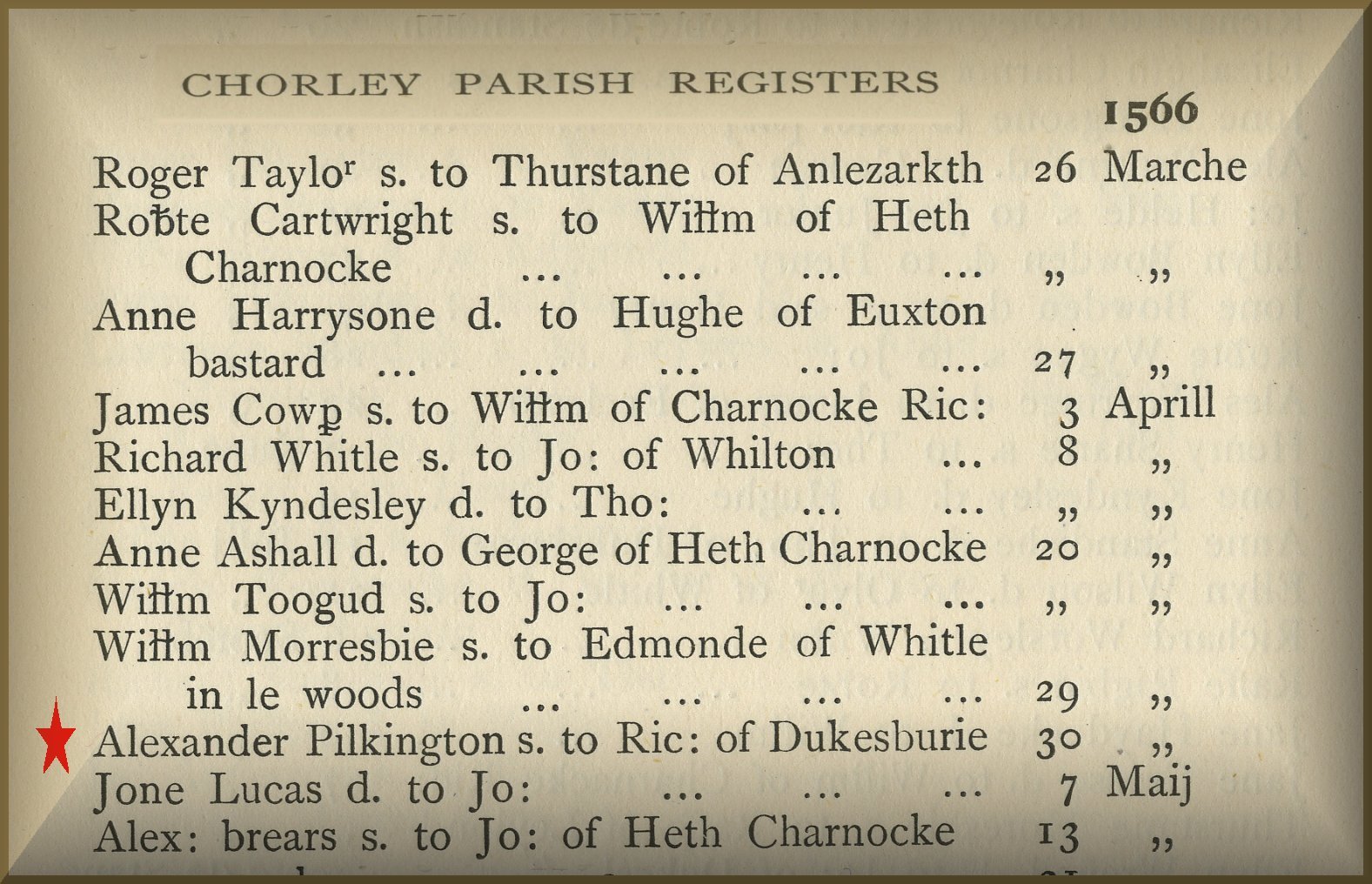
1582. Oliver Pilkington - Manor of Heath Charnock

Manor Court Roll
of Whittle-le-Woods, for the year 1578. from a Private
Archive in Lancashire.
The
heirs of Anthony Crooke The
wife of William Johnson
Ralph
Whitle Richard
Whitle junior
Evan
Haidocke through Oliver
Wylson
Robert Pincocke The wife of Henry Plessington
William
Houghe The heirs of
Roger Pilkington -
James Wygan - Richard Pilkington
Richard
Whitle Robert
Swansey
The
wife of Thomas Pincocke John
Pincocke
Tenants
at will in the year 1578.
Roger
Laylonde Hugh
Phillippe
Persivall
Leylonde The
wife of John Pincocke
John
Estham Roger
Wygan
William
Garstan Gilbert
Whalley
William
Haworthe Edmund
Garstange
John
Yate Hugh
Totehill
James
Hilton Roger
Crooke
William
Houghe The wife of John
Pincocke
John
Pilkington Richard
Estham
The
wife of Thomas Astley Ralph
Leylonde
The
wife of James Pilkington Thomas
Garstange
The
wife of John Garstange Henry
Wythnell
Thurstan
Lucas The wife of
Ralph Worselaye
Edmund
Morresbye Thomas
Haworth
Nicholas
Alredge Henry
Catterall
![]()
Rivington School founded by James Pilkington - Bishop of Durham.
Was Myles Standish Educated at the James Pilkington Grammar School?
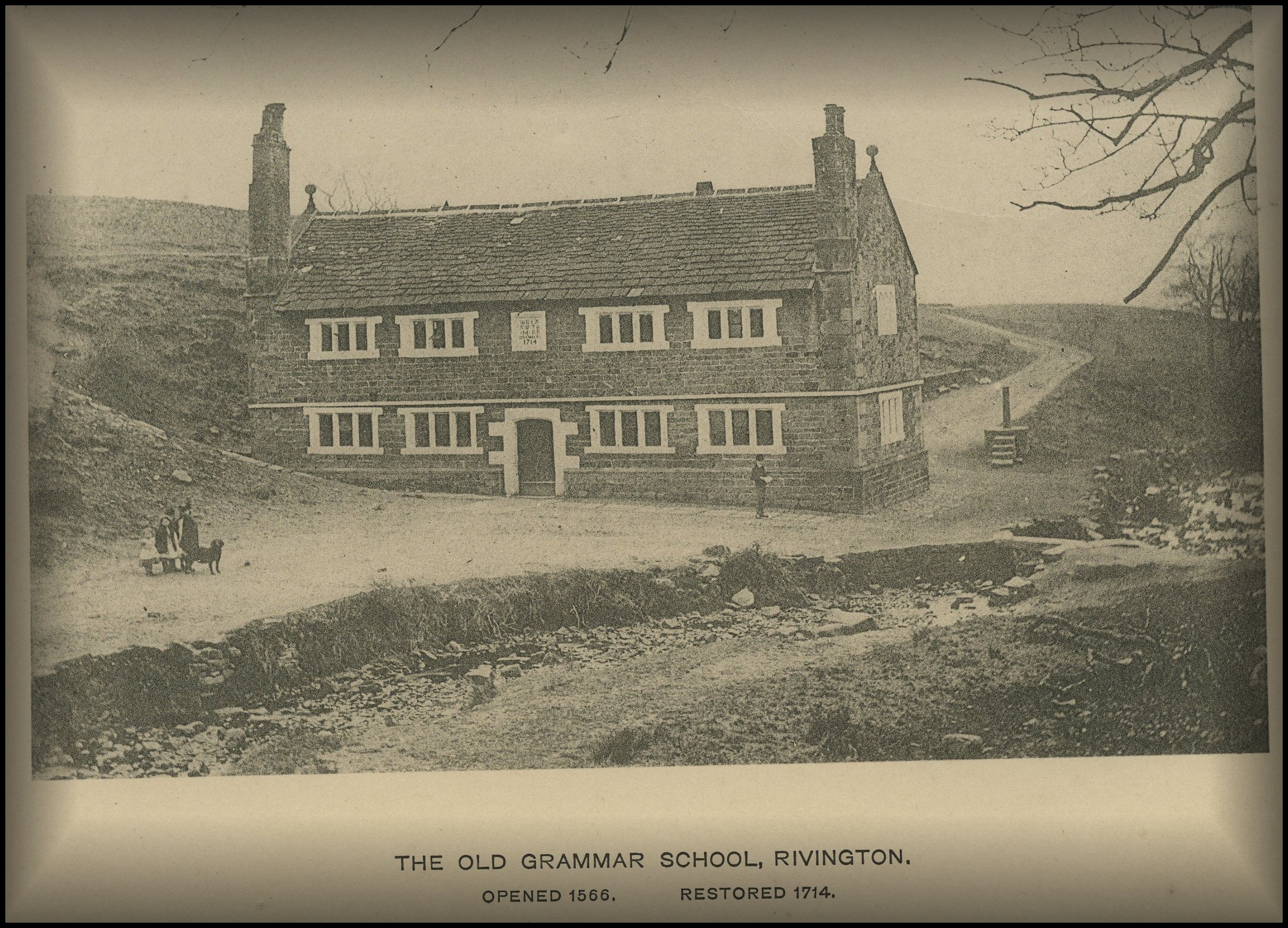
Many learned scholars have made the point that Myles Standish was educated at Rivington Grammar School founded by James Pilkington Bishop of Durham in 1566.
The books listed in the will of Myles Standish in the year 1655 formed a substantial part of the required reading for the curriculum of all the scholars attending Rivington Grammar School.
Not many of the school registers from the early days have survived, but one from the year 1575 has. This register shows the names of the sons of the local gentry in 1575 attending the school.
Two Standish family sons are named -:
(1) Jacobus (James) Standish the son of Christopher Standish of Duxbury from whom the Irish and Canadian branches of the Standish family are descended.
(2) Alexander Standish son of Thomas Standish lord of the Manor of Duxbury 1566 – 1599.
(Christopher Standish the father of James and Thomas Standish the father of Alexander were brothers)
The Library books of Myles Standish in 1655 - by George F Willison.

The Register of Rivington School in the year 1575.
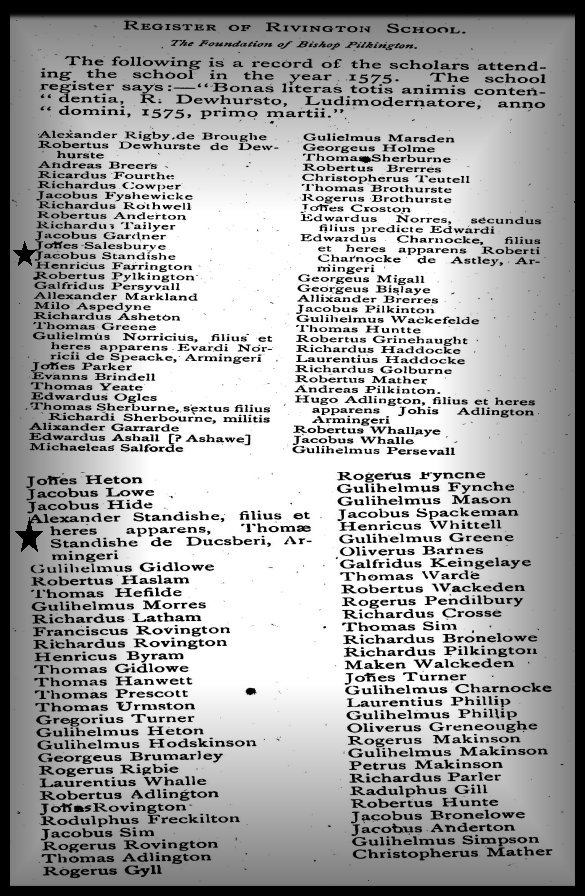
1. Alexander Standish son of Thomas Standish Lord of the Manor of Duxbury 1566 - 1599.
2. James (Jacobus) Standish son of Christopher Standish the founder of the Irish and Canadian branches of the Standish family.
Christopher was the brother of Thomas Standish Lord of the Manor of Duxbury 1566 - 1599

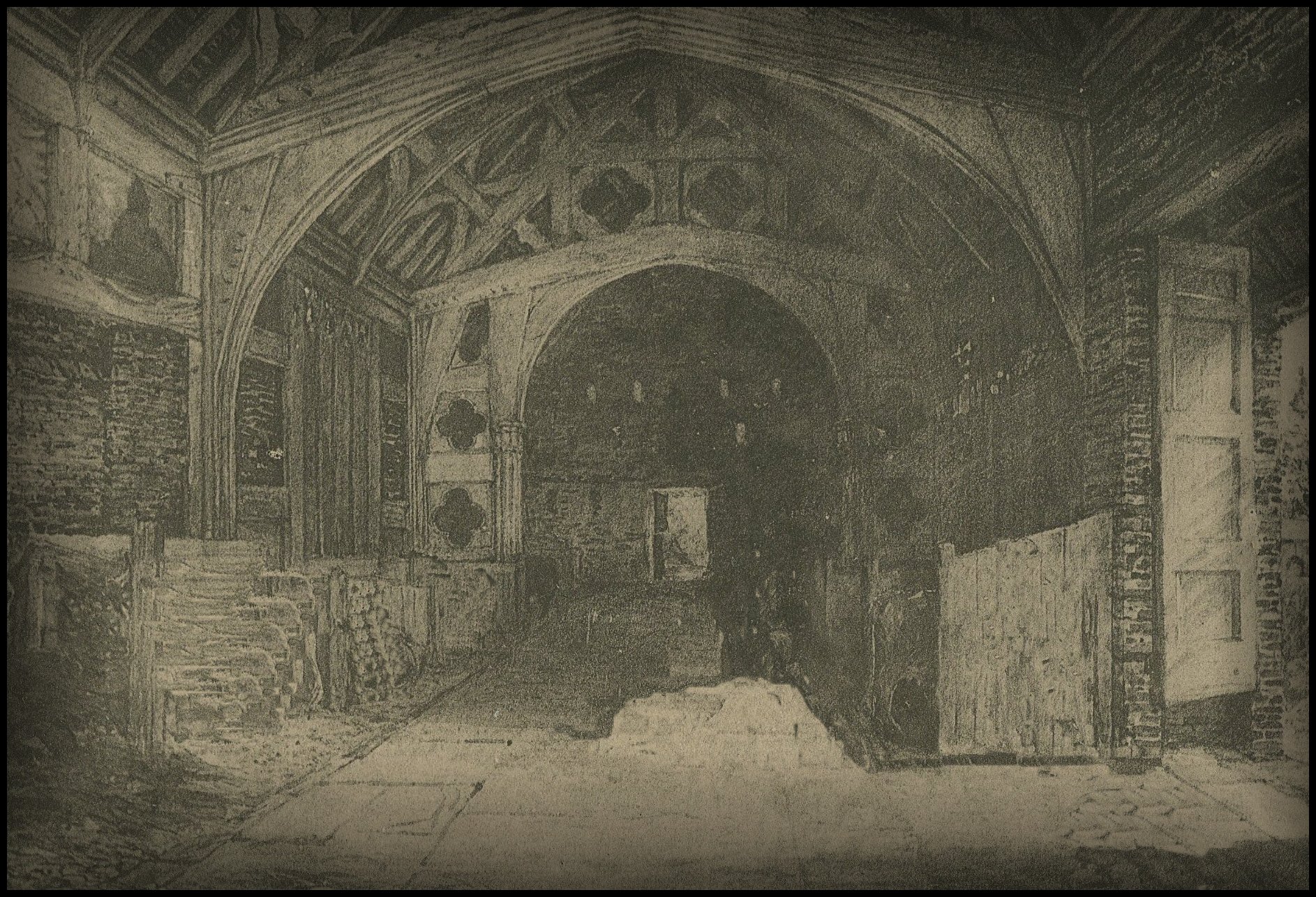
Pilkington Manor - The great Hall of Pilkington 1880 (prior to demolition in 1881).
Pilkington, Leonard (1527–1599), Church of England clergyman,
was born at Rivington, Lancashire, the fifth of seven sons of Richard
Pilkington, esquire (c.1486–1551), and his wife, Alice, daughter of
Laurence or Lawrence Ashawe of Hall on the Hill, Heath Charnock, Lancashire.
Pilkington matriculated at St John's College, Cambridge, as a sizar, and
graduated BA there in 1544. Appointed a fellow at St John's on 24 March 1546,
he proceeded MA the following year. He was named mathematical examiner at St
John's on 5 September 1548, lecturer in mathematics in 1550, and a senior
fellow on 4 September 1551. Nicholas Ridley ordained him deacon at St Paul's,
London, on 15 May 1552, and Pilkington was appointed preacher at St John's at
Michaelmas in the same year. Shortly after Mary's accession he was ejected from
his fellowship, and like his brother James Pilkington fled to the
continent. He may have gone to Frankfurt am Main, for one of the Pilkingtons
arbitrated in a dispute concerning the eucharist in that city's French
congregation in late March 1559. While he was in exile Pilkington married his
first wife, Katherine; they had five children, Alice (d. after 1602),
Grace (d. 1632), Barnabas (d. 1607), Nehemiah (d. 1602),
and Joseph (d. 1622).
Following Elizabeth's accession Pilkington returned to England. After his wife
died, the visitors restored him to his fellowship at St John's on 27 December
1559, and he was ordained priest at Ely in November 1560, appointed Hebrew
lecturer at St John's on 14 January 1561, and collated to the rectory of
Middleton in Teesdale, Durham, including the chapel at nearby Eggleston, on 20
March 1561. He was licensed as a university preacher on 6 June 1561, and, at
Robert Beaumont's suggestion, named master at St John's on 19 October 1561,
succeeding his brother James, who was now bishop of Durham. In the same year
Pilkington received the degree of BTh and was named regius professor of
theology, but he resigned this post the following year and was succeeded by
Matthew Hutton. On 28 August 1563 James Pilkington collated Leonard to the rectory
of Whitburn, Durham, where he amassed a substantial copyhold estate, and where
in 1575 he became enmeshed in a dispute with a parishioner over tithes owed for
a windmill. He became DTh on 28 January 1564. After securing William Fulke's
election as fellow and preacher at St John's in March 1564, Pilkington resigned
his mastership in May, having worked to obtain the appointment of Richard
Longworth as his successor on the 11th. He was collated to a canonry in Durham
Cathedral on 1 August 1567; installed on 6 September, he held this prebend
until his death.
Following James Pilkington's death in 1576, Leonard and his younger brother
John became overseers of the grammar school at Rivington which James had
founded. For failing to attend a visitation conducted by Robert Swift,
chancellor of Durham, at Middleton in Teesdale, Pilkington was excommunicated
on 6 February 1578, though he was absolved five days later and excused from
another visitation in July. By this time the diocese of Durham had become a centre
of controversy, having attracted a number of forward protestants, including
Dean William Whittingham and such prebendaries as Pilkington himself, his
brother John, Ralph Lever, Thomas Lever (deprived in 1567), and John Foxe (who
resigned in 1573). The visitations in early 1578 were the forerunners of
another in October, when Archbishop Sandys of York quarrelled first with
Whittingham, who denied Sandys's right to visit, and then with Dean Matthew
Hutton of York, who had supported the dean of Durham. Pilkington weathered the
storm, and in June 1579 he and his brother John sought Sir Francis Walsingham's
assistance in finding a new dean. In 1592 he was appointed cathedral treasurer.
On 30 September 1597 Pilkington married his second wife, Jayne (née
Dyllycotes), widow of Richard Barnes, bishop of Durham. They had no children.
He died in August 1599, probably at Durham, and was buried in the cathedral
there. In his will, dated 16 November 1598 and proved on 8 September 1599, he
noted that four of his children had already received their inheritances:
Barnabas, a house and copyhold at Whitburn and nearby Cleadon, with other
gifts, amounting to approximately £600; Joseph, money, three farms, and stock
worth at least £400 altogether; and Grace, wife of Dr Robert Hutton (Matthew
Hutton's nephew), and Alice, wife of Francis Laycock, portions of £200 apiece.
To Nehemiah, a minor, Pilkington gave a farm at Hedworth, tithes at Harton,
Durham, and half his personal property. Small bequests were given to his widow,
relatives, and the poor, and 20 nobles were provided for road repair in the
Durham area. To Cambridge he bequeathed seventeen books and a manuscript of
Ælfric's homilies. Jayne Pilkington was buried next to her husband on 20 June
1605.
Richard L. Greaves
C. H. Garrett, The Marian
exiles: a study in the origins of Elizabethan puritanism (1938) · Cooper, Ath. Cantab.,
2.268–9, 550; 3.109 · Fasti
Angl. (Hardy), 3.315, 655, 692
· H. C. Porter, Reform and reaction in Tudor Cambridge (1958) · The
injunctions and other ecclesiastical proceedings of Richard Barnes, bishop of
Durham, ed. [J. Raine], SurtS,
22 (1850) · R. Surtees, The history and antiquities of the county palatine
of Durham, 1 (1816), lxxix; 2 (1820), 52–3 · [J. Raine], ed., Depositions
and other ecclesiastical proceedings from the courts of Durham, extending from
1311 to the reign of Elizabeth, SurtS, 21 (1845) · J. Pilkington, History of
the Pilkington family of Lancashire and its branches from 1066 to 1600, 3rd
edn (1912) · A. M. E. Green, ed., ‘Life of Mr William Whittingham, dean of
Durham’, Camden miscellany, VI, CS, 104 (1871) · W. H. Frere, The Marian
reaction in its relation to the English clergy: a study of the episcopal
registers (1896) · Venn, Alum.
Cant., 1/3.365 · BL,
Lansdowne MS 7, no. 7
BL, Lansdowne MS 7, no. 7
probably over £1400; had
already given landed property to two sons and portions of £200 each to two
daughters; will provided for small bequests to widow, relatives, and the poor,
and 20 nobles for road repair: Injunctions, ed. Raine
![]()
The Nightingale family of Duxbury and Heath Charnock Lancashire.
Myles Nightingale (the son of Myles Nightingale ) was resident on the Manor of Duxbury in 1584 the birth date of Myles Standish and establishes that the Christian name Myles was in use on the Manor of Duxbury in 1584.
A sister of Myles Nightingale married into the Standish family, her husband was James Standish son of of Christopher Standish (authority unknown) and this event provides for the possibility that Myles Nightingale Senior was the grandfather that Myles Standish was named after.
The Christian name Myles was not used by any branch of the Standishf family thus historians have concluded that Myles was named from his mothers line of descent.
1582. Myles Nightingale Manor of Duxbury.

1582. Myles Nightingale Manor of Heath Charnock.

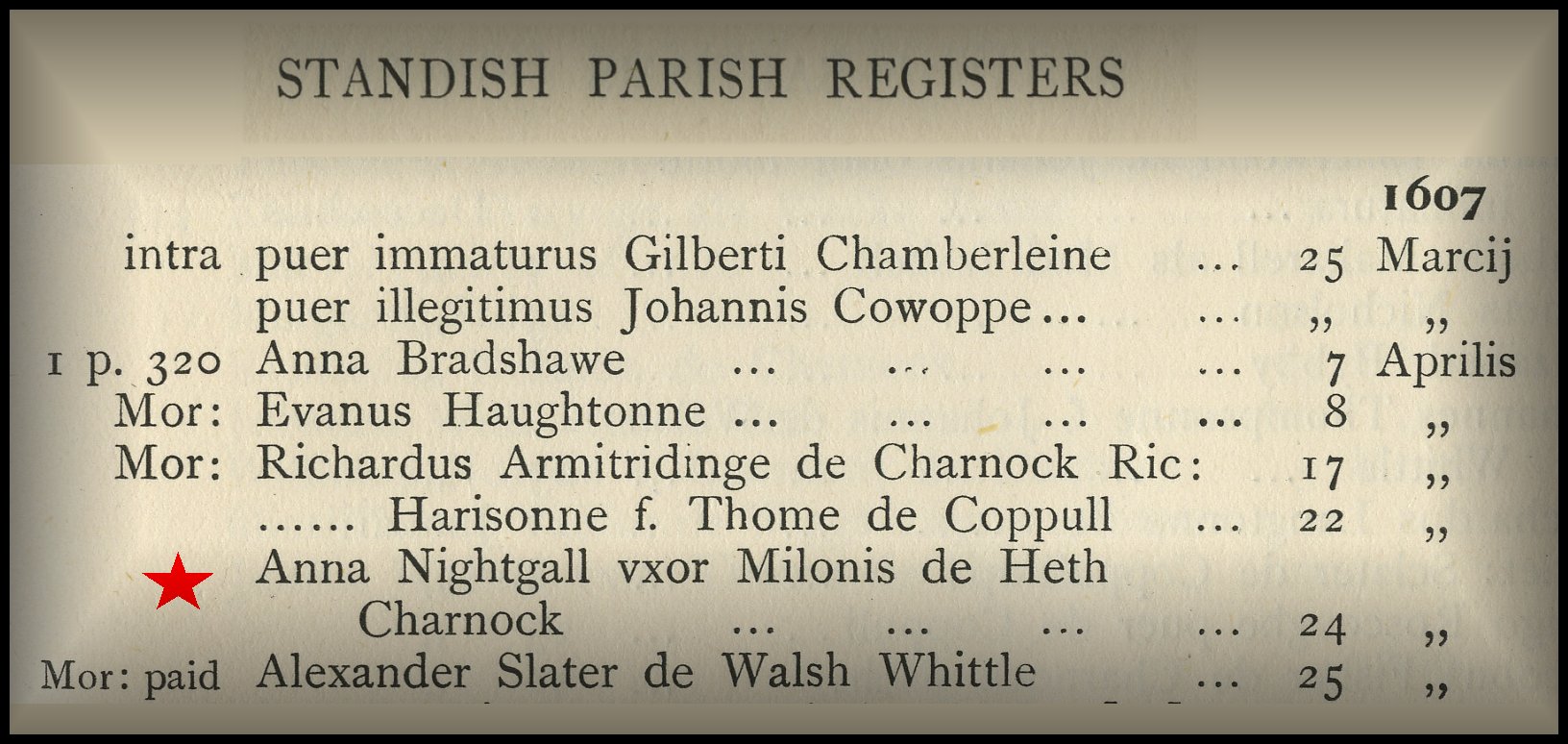
Death of the wife of Myles Nightingale recorded in the register of the Church of St. Wilfrid Standish 24th April 1607.
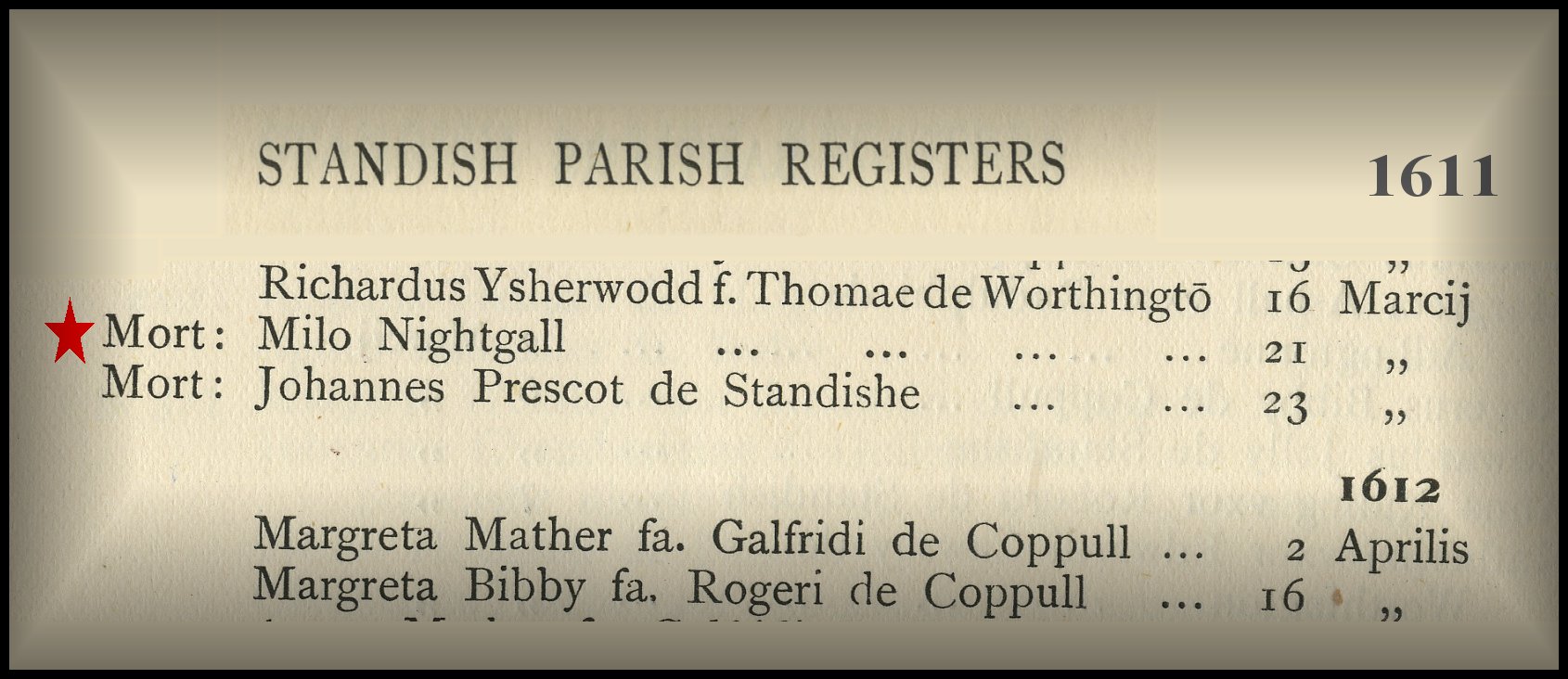
Death of Myles Nightingale recorded in the register of the Church of St. Wilfrid Standish 21st March 1611.

![]()